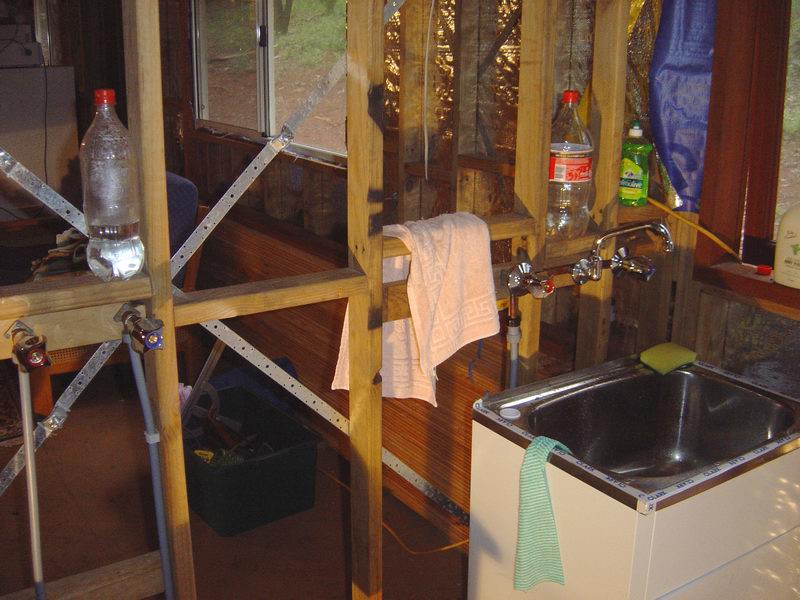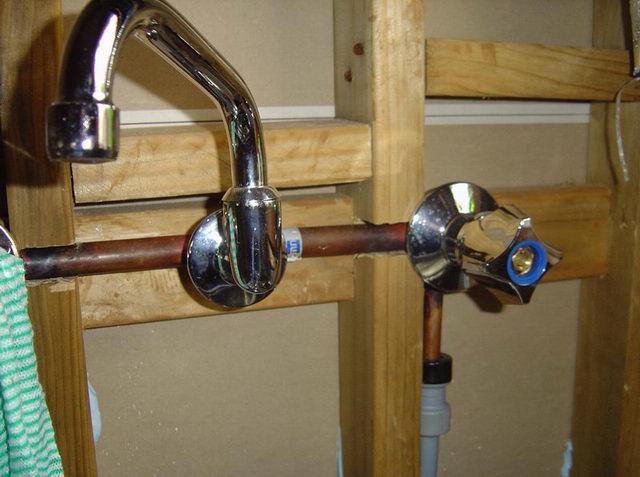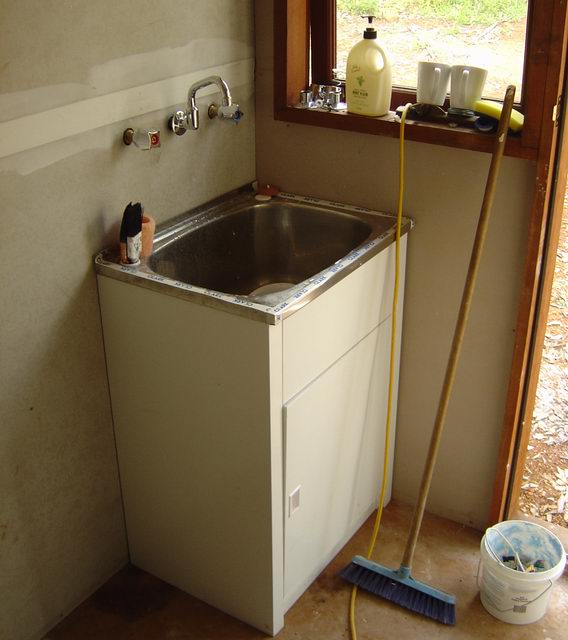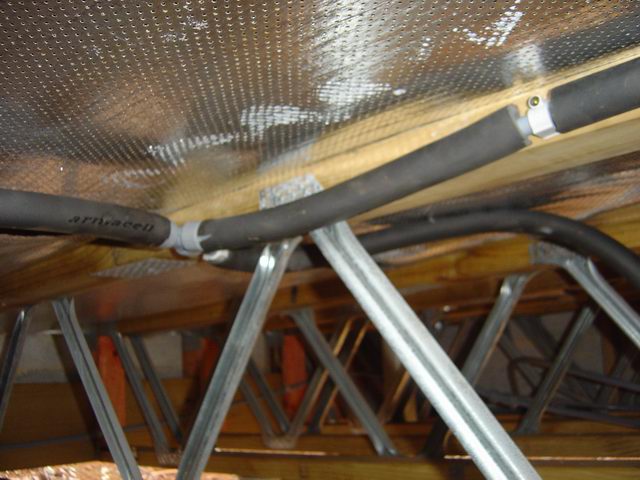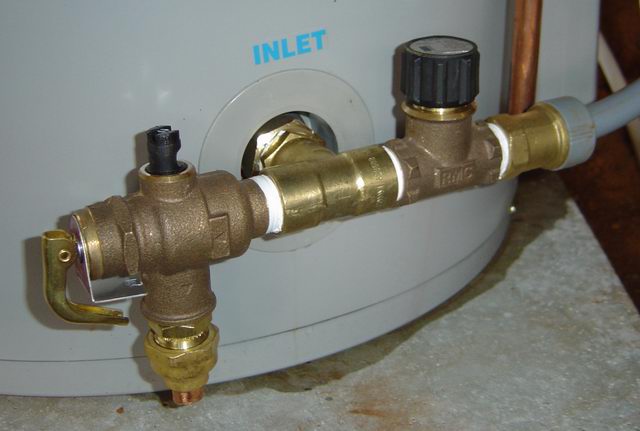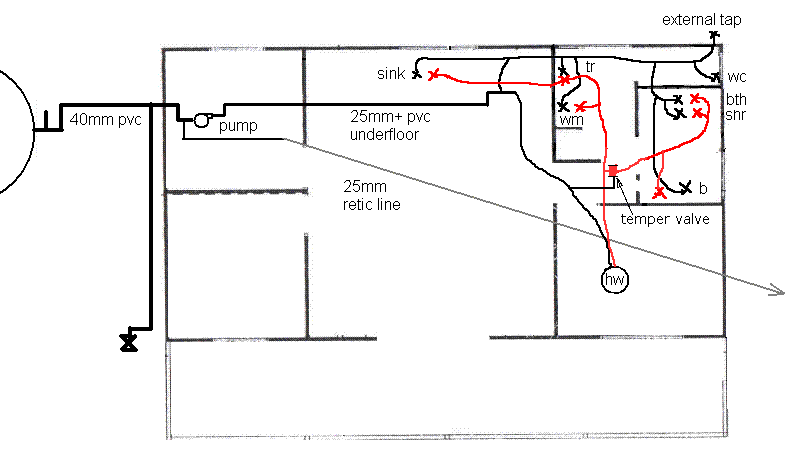The other half of plumbing - pushing clean water around your house. We've got a little pump ready to do the job, let's go.
Right, as usual, you need to have a licenced plumber to do all your plumbing. Even though it is a completely standalone system, your own water caught off the roof and piped through the house and nowhere else, even though the council doesn't even need to have any plumbing plans submitted (they do need drainage plans though), you still need to have a licenced plumber. Got it? Good. Now that we have that out way yet again, let's talk about moving clean fresh rainwater around your house.
Plastic. Well, in fact, 18mm polybutylene to be precise. Good for hot and cold, use it everywhere including right up to your hot water system. Joins couldn't be simpler; "Hepworth" fittings designed for DIY. For instance, if you needed to 'T' your pipe; cut it, insert a metal sleeve into both ends of the cut and the piece to be 'T'd and then push all 3 ends into the Hepworth T-piece. You can then unscrew it if you need to modify it, pop out the pipe, rescrew it back together and it's ready to be used again.
Note that you have to push rather hard. I made the mistake initially of feeble pushes - quite often it needs extra force to get the internal o-ring onto the pipe.
To then terminate the pipe into taps, you can use Hepworth-convert-to-15mm-brass fittings, or Hepworth-to-15mm-copper. Converting from 18mm polybutylene to 15mm copper is also easy; just push the plastic into one end, push the copper into the other end. Notice the pre-made copper trough tap and spout module below. You could make your own all plastic version with the right fittings, but at ~$15 for the tested and ready to go pre-made version, why would you?
You can see some of the different plumbing pieces I used in the previous pile of gear photo here.
Note: be careful with 15mm threaded brass pipe. All male into female screw fittings should positively seal somehow. Rubber grommet, gasket, tapered thread, bottoming out in the fitting, compressing washer, olive - whatever it comes with. A straight thread male into a straight thread female is not really a proper seal - water can escape its way down the threads. Before you start arguing with me, no, thread tape does _not_ make a proper seal so try to avoid it. I had to make a couple of that style thread-tape-only connections, by using 1/2 a kilometer of thread tape per connection it seems to be okay. But does the thread tape degrade over time? In 10 years will all those joints start leaking? I don't know. Try to avoid this situation by using a proper thread seal.
Speaking of thread tape, use it on all your threaded connections regardless.
I was advised to get a plumber around and do a water pressure test. They will pressurise the system harder than what it will normally run at, and see if there are leaks. If it doesn't leak at high pressure then it's not going to leak at normal pressure. Sensible advice - once the walls are on the only way back in is to cut the walls. Painful!
I, erm, didn't heed that advice. Firstly because the only connections concealed in the walls were hepworth and they just work; I have placed my confidence in them. Secondly, all the other connections of pipe are under the house, not in the walls or the roofspace. I can get at them easily if a problem develops.
Hot water - I grabbed a 160L electric storage (decided against putting gas through the house) and mounted it under the house in a convenient spot where it would fit. Now the argument goes that the hot water system should be as close as possible to the sink. Reason being that when you have a shower, you wait until the hot water is flowing, step in and have a (say) 20 minute shower. On the other hand, at the sink, you turn it on, wait for hot water, use it for 20 seconds, turn it off. You do this however several times a day. So rather than drawing off (and thus wasting) a lot of water waiting for hot at the sink, get the hot water system close by!
Hot water systems have two pressure relief valves; one is at 1400kPa at the top, on the hot side. Comes with the hot water system. The other is a 1200kPa unit, you buy and fit on the cold water side. The cold water relief should blow first in the event of a (probably inlet pressure) fault; the hot water relief will blow next if there is a tank pressure fault.
In this picture the water comes in from the right via plastic to a non-return isolating valve. As in, water can only go one way through it and you can turn the knob on top to stop water flow. Next is a T-piece, water goes into the tank and to the cold water relief valve. The piece of copper pipe in the top right of this photo is the pipe for water to flow out of the hot water relief which in that eventuality just spills onto the ground.
Yes, not suprisingly, hot water flows out the top of the tank. I put foamy insulation on all hot water pipe. It's cheap, it saves energy and water.
By law you are required to fit a "temper valve" to the bathroom. This is a device that ensures the temperature of the hot water (in the bathroom only) is 50°C.
I'm both annoyed and dissapointed with this temper valve. Firstly, annoyed, because I run my hot water pretty cool; I don't see the need to have the tank at 75°C (yeah yeah, supposedly "kills bacteria" but what about the massive electricity cost!) and then the temper valve cools it down to 50°C with cold water in the shower. In fact I run my hot water systems at around 55°C. Not to mention the temper valve costs over a hundred bucks.
I was also dissapointed; I was expecting some clever bimetallic strip auto-magic 50°C controlling valve. No. It is merely a normal mixing valve, hot water in one end, cold water in the other, mixed water out the back. You use a thermometer and twist the mixing knob until it measures 50°C out. Bah, what happens when you change the hot water temperature? Yep, you have to "recommission" the hot water system.
Well that about sums it up. I ran hot and cold water to where I needed it and secured the pipes under the house to the trusses with special saddles. Each point where there is a tap screw in a valve and tap (I initially installed temporary plastic blanking plates - when I hadn't bought the taps but wanted to test the system).
There is nothing hard about plumbing; fortunately I had a guy who worked for a plumbing supplier than quietly worked through my drainage and water plans explaining to me what I needed. "Easy when you know how." Thanks Mr Will-Remain-Nameless ;)
